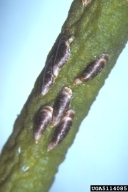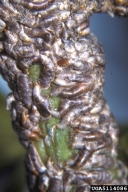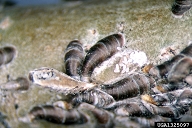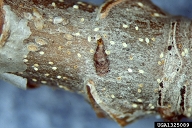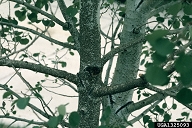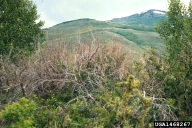Oystershell scale
Lepidosaphes ulmi (L.) (Hemiptera: Diaspididae)
Orientation to pest
Oystershell scale, Lepidosaphes ulmi (L.), is a widespread species of uncertain origin, now found in almost every temperate area in the world. It is known to be invasive in North America, Australia, New Zealand, South Africa, and Japan. It is also found, potentially as a native species, in North Africa and throughout temperate regions of Europe and Asia. It is one of the most polyphagous insects known, reported from 72 different families of plants. Oystershell scale is found mostly on branches and trunks of broadleaf shrubs and trees, in both natural habitats and planted landscapes. The coloration of the adult female varies with the host species. The life history of the species also varies with host, with more generations per year on some hosts and fewer on others. The species overwinters as eggs on all host species. Dense populations may kill branches, whole trees, or even forest stands. This variable cosmopolitan species may in reality be a complex of several biotypes that are being lumped together (see Gharib, 1978). Some populations are parthenogenetic, consisting entirely of females.
Hosts commonly attacked
Oystershell scale is a polyphagous species that attacks many broad leaf woody species, including apple (Malus), ash (Fraxinus), beech (Fagus), birch (Betula), elm (Ulmus), maple (Acer), poplar (Populus), species of Prunus, and willow (Salix).
Distribution
This invasive species is found throughout the United States and southern Canada.
Images of oystershell scale
| Figure 1. Oystershell scale, Lepidosaphes ulmi, is named for the shape of the scale covering, resembling an oyster shell | Figure 2. View of dense colony of oystershell scales | Figure 3. Adult oystershell scale inverted to reveal masses of white eggs, the overwintering stage |
| Figure 4. One female oystershell scale surrounded by recently settled crawlers | Figure 5. Dense population of oystershell scale on aspen in Colorado | Figure 6. Willows in natural habitat killed by oystershell scale |
Important biological control agents related to this pest species
Despite a large literature on this species, relatively little is known about its potential for classical biological control because the species is principally of concern in apple orchards, where the perception is that no scales can be tolerated. But in a forestry or shade tree context, that concern should not apply. Two natural enemies are frequently mentioned in connection with this scale, the predatory mite Hemisarcoptes malus (Shimer) and the aphelid parasitoid Aphytis mytilaspidis (Le Baron). While both of these occur in North America, neither were deliberately introduced. Indeed, little to no work has been done to determine the native range of this scale (likely Central Asia or the Russian Far East) and then determine which species of natural enemies in that area are most effective against low density scale populations. Also, this species of scale may in reality be a complex of species or races and this should be sorted out with DNA methods to show which races are of concern in North America and where are they found in the native range. Finally, even some natural enemies like A. mytilaspidis, which is present in the United State, might be improved by a new introduction of the species that is better adapted to cold areas, where the existing race does not do well but where much of the damage from oystershell scale occurs.
Web links for information on oystershell scale
- Fact Sheet | Colorado State University Extension
- Fact Sheet | Pennsylvania State University Extension
- Species Catalog on ScaleNet
Complete list of all recorded natural enemies, hosts, and distribution records; also an index to all publications on this species
Articles
- Gharib, B. 1978. On two new distinct biological races of Lepidosaphes ulmi L. (Homoptera, Coccoidea, Diaspidinae). Comptes Rendus Hebdomadaires des Seances de l'Academie des Sciences, D 286(18): 1313-1314. (in French)
